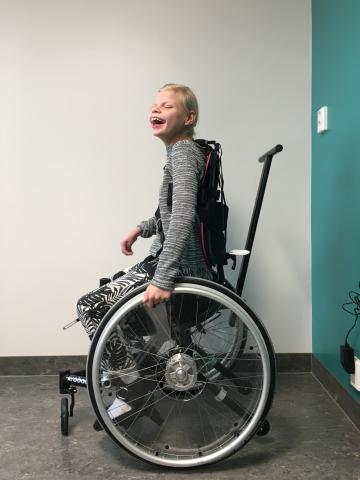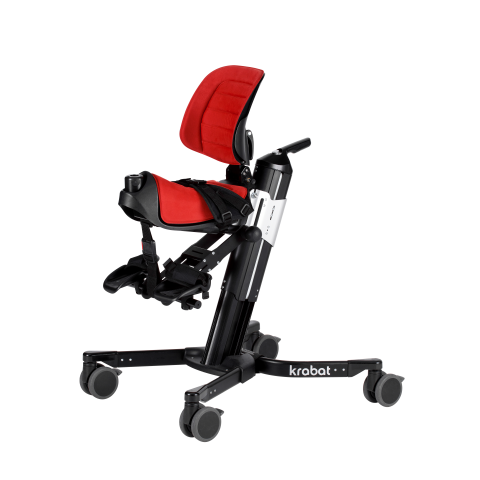When hippotherapy was examined, what therapists and parents saw was that special needs children arrived to their hippotherapy sessions in wheelchairs with lots of upper body support.

As soon as the children were placed on a horse they sat more upright and needed less extra support. Obviously some of this result could be attributed to the horse and its movements, but the Krabat team wanted to investigate this further.
The clinical and development team at Krabat wanted to look at why the saddle seat had such a positive effect on sitting posture and wondered if these effects could be transferred to a chair.
In order to understand what happens when sitting on a saddle we need to look at the anatomy of the spine and pelvis.
On the left side of this image shows the spine of a person standing. On the right side of this image shows the spine of a person sitting on a flat seat with their pelvis tilted backwards. The position of the pelvis effects the rest of the body’s structures.
Research by Keegan (1953) and Bashir (2004) on this field found the following:
Keegan did an X-ray study in supine position and found that flexion of the hips more than 60 degrees makes the pelvis tilt back and the lumbar lordosis flattens.
Bashir and co-workers confirmed this in 2006 with the help of MRI, that the best seated posture is the open angle (135 degree) trunk-thigh posture. Of the three seated positions tested in the study, this appears to cause the least strain on the lumbar spine. “A 135-degree body-thigh sitting posture was demonstrated to be the best biomechanical sitting position, as opposed to a 90-degree posture, which most people consider normal” (Dr. Bashir).
Comparing the Flat seat to the Saddle seat the following is visible:
| Flat Seat | Saddle Seat |
| Pelvis in 90 degrees | Pelvis in open angle |
| Feet in front | Feet underneath |
| Spine in C-curve | Spine in S-curve |
| Slumped position | Upright position |

Use of a Saddle seat provides increased postural control. This is possible by starting with a stable base, with the pelvis in a neutral position.
As the spine image above shows, it is not possible to maintain a neutral pelvis over time if the hips are in a 90 degree angle. The legs need to be lowered, and only then can the normal spinal curves be maintained.
Weightbearing is achieved through the ischial tuberosities (sitting bones), resulting in open hip angle and abducted hips.
The idea of a saddle seat is not a new concept, Saddle seat options have been around for a number of years.
It’s possible to see dentists, surgeons, hairdressers all use a Saddle seat when working. The Saddle seat provides them with the best possible position to work with their hands. The Krabat team wanted to see if more special needs children could also benefit from this way of sitting.
Correct feet positioning as achieved when sitting in a Saddle seat promotes:
- Spinal alignment
- Symmetry
- Balance
When seated in a Saddle seat, activity participation is assisted through the following:
- A stable lower body allows for a more active upper body
- An upright sitting position can improve head control, which in turn can give a better visual feedback
- Better reaching conditions and hand-eye coordination
- Enhanced upper extremity activity
To summarise: Physiological benefits of using a saddle seat
By opening the angle of the hips, the pelvis is neutrally positioned. With the pelvis neutral, the natural S-curvature of the spine can be maintained over time.
All major joints in the lower extremities become centered, which promotes normal muscle tone and muscle length. The hip joint is in its resting position in which the femoral head is positioned inside the hip socket.
The sitting position in the Saddle seat can prevent complications such as muscle contractures, hip pain and subluxations. The Saddle seat also enhances an active, upright seating position rather than a passive, slumped one.
Contact Medifab if you would like to arrange trial of a Saddle seat option with someone you know!








